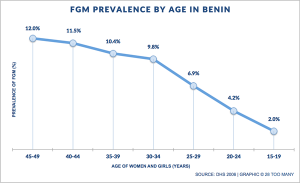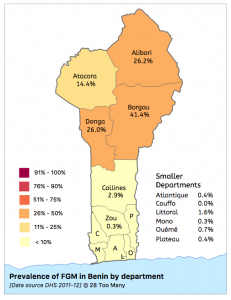Related Articles
Africa
02 March 2019

11.5 million
9%
2.77%
2%
Girls in Benin commonly undergo female genital cutting (FGC) Type II procedures.
[Source: UNICEF, DHS and MICS]
85.3% of women aged 15-49 who have undergone FGC were cut before the age of 15.
Almost all FGC in Benin is carried out by traditional practitioners.
Illegal. Since March 2003, the law in Benin has prohibited the practice of FGC.
Penalties range from fines for failing to report FGC to imprisonment of up five years for those who aid, abet or carry out the procedure. Where FGC results in a woman or girl’s death, the punishment ranges from five to 25 years’ forced labour.
Actual cases in which these laws were enforced have not been identified, however.
National progress
Source: 28 Too Many
163 in 2018 index, based on 2017 data.
64 deaths per 1,000 live births (2015).
405 deaths per 100,000 live births (2015).
There was a modest fall in overall prevalence from 12.9% in 2006 to 7.3% in 2011-12. This figure may not fully reflect the progress that has been made recently, due to the large age range of women included in the data. Among younger women the data suggest a clear downward trend.

Source: 28 Too Many
By region:
Within Benin, the areas of highest FGC prevalence are in the north: Borgou (41.4%), Alibori (26.2%), Donga (26.0%) and Atacora (14.4%). They sit in contrast with Couffo province, in which no instances of FGC are recorded, and six of the remaining 12 departments, in which FGC prevalence is less than 1%.

Peulh, Borgou, Lokpa and Yoa, Donga
Stay up-to-date with stories of change, news and research about ending female genital cutting by signing up to our newsletter.
If you have any questions, please get in touch.
4.3 million girls around the world are currently at risk of being cut every year.
Your donation will help us accelerate an end to female genital mutilation/cutting (FGM/C) around the world.
